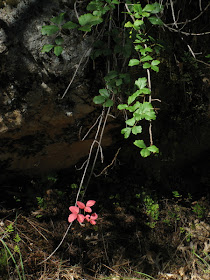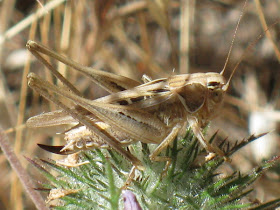Distance Hiked: just under 12 miles out and back
Elevation Change: 2582 feet per Garmin Basecamp
Trail Tread Types: Pine needle covered packed soil, double tread to single tread, loose rocks, wet and dry stream beds.
Driving Directions: We drove on I-5 to Central Shasta exit, then followed signs to Castle Lake. Go to Wikiloc Trails for GPS tracks; a small map is shown below.
The trail was mostly clear to follow but GPS helped us navigate since in some places it simply vanished. Long sleeves and long pants (convertibles) with good hiking boots and poles are recommended due to thick overgrown manzanita.
There were swimmers and fishermen and a crowded parking area when we arrived, but they filtered out quickly as evening approached and we found our first campsite by following the trail to the left toward a small creek crossing.
| TAKE THE BUG SPRAY! No Joke! |
Several campsites are available alongside this trail toward the east of the lake, but we veered left at a small fork and meandered until we found our more private site away from the lake and its visitors. The creek (possible water source) near us was through this little bushwhacking shown in the left photo above.
The trail starts at Castle Lake and climbs to the east of the lake.
There is an unnamed pond and then you'll come to Little Castle Lake (not much more than a pond and difficult to get close to due to the thick brush.
The trail ranges from rocky to meadows to forest to very old double tread and through unmanaged vegetation. We had luck with breezes to cool us despite a hot day and areas without shade.
Hike uphill through the forest and then you begin crossing the saddles and will find astoundingly beautiful views, one after another.
The heavy manzanita is difficult to wedge through especially if you are wearing a pack. It stood taller than us and caught on my pack, pockets, poles, shoes..... but onward to the promising views that are as breathtaking as any hiker imagines.
| "The Crags" |
| Sneak previews of Shasta along the trail ahead. |
| Black Buttes |
| More of Shasta tantalizing hikers onward! |
| Mount Bradley Lookout |
This hike could be satisfying and shorter if you stop at the last saddle. It is a narrow old section of wide rocky trail but the views, in our estimation, were best from the top of the peak before the last saddle that crosses to the lookout. If you're interested in the historic and now unmanned lookout, it was a pleasant resting place.
As we continued......
Upon our return to camp, having hiked this as an "out and back", we found a closer camp than before and settled in. The bugs must have bred while we were away...I was sure there were more of them!
Here are some shots of the lake (and flowers) before the breezes or people disturbed it in the morning:
Castle Lake is very shallow at the side nearest parking, but is 120 feet deep across on the granite side of the bowl, and its surface covers 47 acres. It is classified as a glacial lake.
Enjoy your hike and let me know how you fare!
I read an account of this hike in Trinity Alps Vicinity by Mike White. He offers a multitude of hikes in the area with directions and extensive details. Note that it can't be updated about trail conditions so check out your interests with the Forestry and the internet before you set out on your hikes.
Trinity Alps (near Redding, CA)
|
miles
| |
40ish
|
Strenuous
| |
12
|
Strenuous and Difficult
| |
backpack
|
Strenuous!
|
Peachy Hiker's Table of Contents
Happy Trails!
Edited 7-2014

